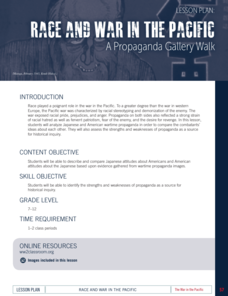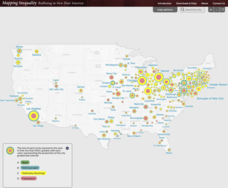PBS
The Legacy of To Kill a Mockingbird: Continuing Atticus’s Fight for Justice
Tom Robinson was only one man in Harper Lee's To Kill a Mockingbird, but he represents many people throughout history who have not found justice in the American justice system. Language arts students discuss the theme of social justice...
Digital Public Library of America
Teaching Guide: Exploring To Kill a Mockingbird
Harper Lee's To Kill a Mockingbird, considered by many to be a seminal piece of American literature, contains many complex literary themes that carry through United States history. Use a series of discussion questions and classroom...
National WWII Museum
Race and War in the Pacific: A Propaganda Gallery Walk
Race played a key role in the war in the Pacific during World War II. Using images from both American and Japanese sources, learners consider racial propaganda and how leaders used it to rally popular support during the conflict. After...
University of Richmond
Mapping Inequality: Redlining in New Deal America 1935-1940
Redlining—or the practice of racial discrimination in housing loans—directly led to today's segregated living patterns in America. Using data from the federal Home Owners' Loan Corporation, classmates visualize the impact of policy on...
University of Richmond
Renewing Inequality: Family Displacements through Urban Renewal 1950-1966
What is progress? Who bears its cost? High schoolers consider the questions as they review data on families displaced by urban renewal projects in the 1950s and 1960s. An interactive, curated data project asks historians to consider the...
Pace University
The Harlem Renaissance - The Journey to Freedom: An Interdisciplinary
The Harlem Renaissance if the focus of a carefully crafted, interdisciplinary unit designed to introduce middle schoolers to the contributions key figures made to American art and culture during the period. Class members select...
PBS
Ken Burns: Jackie Robinson Taking the Measure of a Man
During his first few games as the first black player in Major League Baseball, Jackie Robinson proved that he could withstand the wily curveball of Johnny Sain as well as the racial epithets shouted from opposing teams' dugouts. A short...
Free Library of Philadelphia
Resources for Ghost Boys
Jewell Parker Rhodes, the author of Ghost Boys, wanted to bring the historical legacy of Emmett Till and the current topic of racial prejudice into today's young readers' mindsets. Use a reading guide and set of discussion questions to...
Anti-Defamation League
The Hate U Give
The Hate U Give by Angie Thomas became a quick hit in the young adult literature genre before its adaptation in the 2018 film of the same name. Use a thorough lesson, discussion guide, and series of activities to discuss the social...
National Park Service
Teaching with Historic Places: Discover the Jackie Robinson Ballpark
Can sports and popular culture change public opinion? That's the essential question asked by a lesson plan that looks at the role Jackie Robinson's appearance at City Island Ballpark in Daytona Beach, Florida played in the desegregation...
PBS
Ken Burns: Jackie Robinson - A Journey Back to Separate but Equal Conditions
Baseball great Jackie Robinson fought for social justice. His efforts to push for equal access are detailed in an episode from from the Ken Burns: The Jackie Robinson Collection. After viewing the clip, class members engage in a series...
PBS
Ken Burns: Jackie Robinson Integration or Separation?
What happens when change you imagined, the change you were promised, is slow in coming or doesn't happen at all? What do you do with the frustration and disenchantment? Class members watch two clips from the Ken Burns: Jackie Robinson...
PBS
Ken Burns: Jackie Robinson Living in Jim Crow America
Your class members may know that Jackie Robinson was the first African American man to play Major League Baseball, but they may not be aware of his efforts to achieve social justice. A clip from Ken Burns: The Jackie Robinson Collection...
Core Knowledge Foundation
Ray Charles
Introduce young learners to the read-aloud process with a short biographical passage about Ray Charles. After listening to the passage, class members respond to factual, inferential, and evaluative questions, and then create a timeline...
Look! We're Learning!
Ella Fitzgerald Biography Mini-Unit
Before there was Beyonce, before there was Madonna, before there was Cher, there was Ella. Introduce Ella Fitzgerald, The First Lady of Jazz, with a reading comprehension exercise that presents a brief biography of her life and then asks...
Maryland Department of Education
A Raisin in the Sun and Dreams Deferred
To conclude a study of A Raisin in the Sun and to prepare for a visit to the Lewis Museum, class members analyze Langston Hughes' poem "Harlem." Learners then draw connections to characters in the play and to their own experiences by...
Reading Through History
Tulsa Race Riots
How did the 1921 riots in Tulsa start? Pupils read information about the riots that occurred in Tulsa. Following the reading, they answer multiple-choice questions and guided reading questions to help them along the way.
Orlando Shakes
The Best of Enemies
History comes to life with the play The Best of Enemie. Scholars learn literary elements as well explore racial issues in American history. The play is based on a true story and addresses the universal truth that people are capable of...
Learning to Give
The Beginning of the Storm
Introduce readers to Mildred Taylor's Roll of Thunder, Hear My Cry with a lesson that sets the context for the novel. Class members research the bigotry in Mississippi during the Great Depression and identify examples in the story of how...
Learning to Give
What Are Your Thoughts?
The varying responses of the characters in Mildred Taylor's Roll of Thunder, Hear My Cry to the discrimination they experience or perpetrate provides readers with an opportunity to not only examine the feelings of the characters but to...
Described and Captioned Media Program
Malcolm X: Make It Plain, Part II
Track the transformation of Malcolm Little into Malcolm X and then into El Jajj Malik El-Shabazz with the second part of Make it Plain, a documentary on the famous civil rights activist. Viewers consider not only how events shaped and...
Described and Captioned Media Program
Malcolm X: Make It Plain, Part I
Malcolm X was a complicated man that few in white America understood. After sharing what they know or think they know about this civil rights leader, about nationalism and Black Nationalism, class members view a two-part documentary...
Little Stones
How Can Poetry Make People Think and Care?
Can beautiful words change the world? Literary scholars discover how to paint their visions of change using poetry in a series of three workshops. Each independent topic gives participants a chance to examine their feelings about...
Wisconsin Historical Society
Civil Disobedience
When is civil disobedience acceptable? Class members read examples of Jim Crow laws, an excerpt from Dr. Martin Luther King's "Letter from a Birmingham Jail," and a newspaper article and then consider the factors that make a law just or...

























